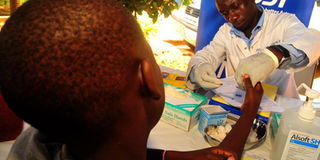How adolescents living with HIV are coping

A boy undergoes an HIV test. Recent studies show an increase in HIV infection among adolescents worldwide. Photo by Stephen Wandera.
What you need to know:
Many young people who were infected at birth are now adolescents, yet most do not receive the care and support needed to say in good health.
Charles Kintu (not real name) is always as lively as any teenager should be. And every week day, the 15-year-old basketball fan, ensures he leaves school as soon as the 4pm bell rings so he can be home in time for his daily game practice.
Kintu’s dream is to become a professional basketball player. When you see him running around the court with a ball, you can hardly tell he is HIV-positive. The Senior Three student says he was born with the virus, after his then teenage mother got pregnant with him.
“She was in Senior Six and because she was afraid of what her parents would do, she disappeared from home and went to the village.”He adds: “Since she never went for antenatal visits throughout the pregnancy, she did not know she was HIV-positive and even at the time of delivery, she was helped by one of the elderly women around home.” Kintu says his mother learnt about his status at three months, after taking him to hospital because he was sickly.
The numbers
Kityo is one of seven per cent (seven out of every 100) adolescents aged between 15 and 24 who were living with HIV in Uganda, by 2009, according to a report by the United Nations Children’s Fund (Unicef).
While some of the adolescents get infected as a result of being sexually active without taking any precautions, Kityo’s case is different because he was infected at birth, through mother-to-child transmission.
Uganda Aids Commission (UAC) that 18 per cent of all HIV infections in the country happen through mother-to-child transmission.
Unicef estimates show 20,600 new paediatric HIV infections were reported in 2011 alone. Globally, the World Health Organisation says more than two million adolescents between the ages of 10 and 19 years are living with HIV/Aids, yet many do not receive the care and support that they need to stay in good health and prevent transmission. And, many more adolescents are at risk of infection.
WHO says the failure to support effective and acceptable HIV services for adolescents has resulted in a 50 per cent increase in reported Aids-related deaths in this age group compared with the 30 per cent decline in the general population from 2005 to 2012.
Challenges
“Adolescents face difficult and often confusing emotional and social pressures as they grow from children into adults. Adolescents need health services and support, tailored to their needs. They are less likely than adults to be tested for HIV and often need more support than adults to help them maintain care and to stick to treatment,” says Dr Gottfried Hirnschall, Director of WHO HIV/Aids department. And while young people like Kityo are embracing positive living, many others who are HIV-positive do not know their status.
One of the challenges for people living with HIV in Uganda is the low levels of testing and lack of timely anti-retroviral treatment initiation, which is why one third of infants living with HIV die before their first birthday, and half die before the age of two years.
Unicef says in many low and middle income countries such as Uganda, the vast majority of children diagnosed with HIV do not begin ART on time.
“We need to work together to reach out to these mothers and children if we are to achieve the 2015 deadline for the Millennium Development Goals (MDGs),” says Ahunna Eziakonwa-Onochie, the resident coordinator for the United Nations Development Programme in Uganda.
In Kintu’s case, family support has ensured that he lives.
“I hear people say when you are HIV-positive, you are always sickly, but my mother ensures I have a balanced diet and I take my medication as required. This has kept me healthy,” says Kintu.
“I take my medication every morning before I leave home. I do not do any special exercise besides playing basketball,” he adds.
Across sub-Saharan Africa, many adolescents who were infected at birth are becoming adolescents.
In addition to the many changes associated with adolescence, they also face the challenges of living with a chronic infection, disclosing the news to friends and family and preventing transmission to sexual partners.
“Adolescent girls, young men who have sex with men, those who inject drugs or are subject to sexual coercion and abuse are at highest risk. They face many barriers, including harsh laws, inequalities, stigma and discrimination which prevent them from accessing services that could test, prevent, and treat HIV,” says Craig McClure, Chief of HIV programmes for Unicef.
“About one-seventh of all new HIV infections occur during adolescence. Unless the barriers are removed, the dream of an Aids-free generation will never be realised.”




